中国文化典籍英译
24部中国名著英语翻译大全

本⽂是为您准备的《24部中国名著英语翻译⼤全》请⼤家参考!《西游记》Pilgrimage to the West; Journey to the West《三国演义》The Romance of the Three Kingdoms《红楼梦》A Dream in Red Mansions (The Story of the Stone)《⽔浒传》 Heroes of the Marshes; Water Margins《本草纲⽬》 Compendium of Materia Medica《聊斋志异》 Strange Tales of a Lonely Studio《论语》 Analects of Confucius《⼭海经》the Classic of Mountains and Rivers《围城》 A Surrounded City《西厢记》 The Romance of West Chamber《资治通鉴》 History as a Mirror《史记》 Shi Ji/ Historical Records四书(《⼤学》、《中庸》、《论语》、《孟⼦》)The Four Books (The Great Learning, The Doctrine of the Mean, The Analects of Confucius, The Mencius)《阿Q正传》 The True Story of Ah Q《春秋》 Spring and Autumn Annals《论语> THE ANALCETS OF CONFUCIUS《诗经> the book of odes《世说新语》 essays and criticism (shi shuo hsin yu)《封神演义》 the legend of deification《⾦瓶梅》 The golden lotus《西厢记》 The west chamber。
中华优秀传统文化英文书籍

中华优秀传统文化英文书籍
中华优秀传统文化英文书籍有很多,以下是一些推荐的书籍:
1. 《论语》英文译本:Confucius: The Analects,杨伯峻译,外语教学与研究出版社
2. 《道德经》英文译本:The Tao Te Ching,陈鼓应、白奚译,北京大学出版社
3. 《大学》英文译本:The Great Learning,王文锦译,中华书局
4. 《中庸》英文译本:The Doctrine of the Mean,程昌明译,九州出版社
5. 《孟子》英文译本:Mencius,杨伯峻译,中华书局
6. 《墨子》英文译本:Mozi: A Translation and Study of the Complete Works,梅贻宝译,中华书局
7. 《庄子》英文译本:Chuang Tzu: The Inner Chapters,陈鼓应、白奚译,商务印书馆
8. 《周易》英文译本:The Book of Changes,刘大钧、林忠军译,上海古籍出版社
9. 《诗经》英文译本:The Book of Songs: The New Bilingual Edition,许渊冲译,北京大学出版社
10. 《礼记》英文译本:The Book of Rites,杨天宇译,上海古籍出版社
以上是一些中华优秀传统文化英文书籍的推荐,希望对您有所帮助。
中国文化典籍英译版本

中国文化典籍英译
An Anthology of Chinese Masterpieces in English Translation I
1. 神话传说(Myth)
女娲补天·淮南子
2. 寓言(fable)画蛇添足·战国策
3. 诗经
(Book of Songs 或 Book of Odes )
中国的诗歌传统“诗六艺”:风、雅、颂、赋、比、兴,
始成于《诗经》。
风、雅、颂是诗歌分类,赋、比、兴是创作方法。
“风土之音曰风,朝廷之音曰雅,宗庙之音曰颂”。
4. 楚辞(Elegies of Chu, Songs of Chu, The Verse of Chu, Chu Ci)
离骚: Grief of Parting
5. 老子《道德经》(Lao Zi,The Way and Its Power)--- 道家(Taoism)
6. 庄子(Zhuang Tzu)
论语 [春秋] 孔子
The Analects / Lun Yu by Confucius
理解的困惑
Arthur Waley 亚瑟·威利Analects of Confucius Thomas Cleary 托马斯·柯立瑞Essential Confucius
唐诗
宋词
元曲
明清小说红楼梦。
中国古代部分书籍名著的英文译名

中国古代部分书籍名著的英文译名中国古代部分书籍名著的英文译名《本草纲目》 Compendium of Materia Medica《红楼梦》 A Deam in Red Mansions (The Story of the Stone) 《聊斋志异》 Strange Tales of a Lonely Studio《论语》 Analects of Confucius《三国演义》 The Romance of the Three Kingdoms《山海经》 the Classic of Mountains and Rivers / Mountain and Sea Classics《围城》 A Surrounded City《西厢记》 The Romance of West Chamber《西游记》 Pilgrimage to the West; Journey to the West《资治通鉴》 History as a Mirror《水浒传》 Heroes of the Marshes; Water Margins《大学》The Great Learning《中庸》The Doctrine of the Mean《论语》The Analects of Confucius《孟子》The Words of Mencius《诗经》The Book of Songs《书经》The Book of History《易经》The Book of Changes《礼记》The Book of Rites《春秋》The Spring and Autumn Annals《战国策》Stratagems of the Warring States《史记》Records of the Grand Historian《世纪新说》New sayings of the World《西行漫记》Red Star over China|考试大收集整理1.四书 The Four Books2.五经 The Five Classics3.《大学》 The Great Learning4.《中庸》 The Doctrine of the Mean,The Way of Medium5.《论语》The Analects of Confucious,The Confucious Analects6.道德经 The Classic of the Virtue of the Dao,The Book of Lao Zi,Dao De Jing7.《孟子》 The Work of Mencious,Mencious8.《书经/尚书》 The Book of History9.《易经/周易》 The Book of Changes10.《礼记》The Book of Rites,The Book of Social Changes Ceremonies11.《春秋》 The Spring and Autumn Annals12.《史记》 History of Records,Records of the History13.《楚辞》 Poetry of the South14.《左传》 Zuo Commentary(Spring and Autumn of Mr.Lu)15.《孙子兵法》 The Art of War16.《墨子》 Modi17.《非攻》 Condemnation of Offensive War18.《商君书》 The Book of Lord Shang19.《更法》 The Reform of the Law20.《过秦论》 The Faults of Qin21.《完壁归赵》 Return the Jade Intact to the State of Zhao22.《毛遂自荐》 Mao Sui Recommends Himself23.《苏武牧羊》 Su Wu Tends Sheep24.《洛神赋》 The Goddess of the Luo25.《出师表》 Memorial on Going to War。
中国古代部分书籍名著的英文译名

中国古代部分书籍名著的英文译名中国古代部分书籍名著的英文译名《本草纲目》 Compendium of Materia Medica《红楼梦》 A Deam in Red Mansions (The Story of the Stone) 《聊斋志异》 Strange Tales of a Lonely Studio《论语》 Analects of Confucius《三国演义》 The Romance of the Three Kingdoms《山海经》 the Classic of Mountains and Rivers / Mountain and Sea Classics《围城》 A Surrounded City《西厢记》 The Romance of West Chamber《西游记》 Pilgrimage to the West; Journey to the West《资治通鉴》 History as a Mirror《水浒传》 Heroes of the Marshes; Water Margins《大学》The Great Learning《中庸》The Doctrine of the Mean《论语》The Analects of Confucius《孟子》The Words of Mencius《诗经》The Book of Songs《书经》The Book of History《易经》The Book of Changes《礼记》The Book of Rites《春秋》The Spring and Autumn Annals《战国策》Stratagems of the Warring States《史记》Records of the Grand Historian《世纪新说》New sayings of the World《西行漫记》Red Star over China|考试大收集整理1.四书 The Four Books2.五经 The Five Classics3.《大学》 The Great Learning4.《中庸》 The Doctrine of the Mean,The Way of Medium5.《论语》The Analects of Confucious,The Confucious Analects6.道德经 The Classic of the Virtue of the Dao,The Book of Lao Zi,Dao De Jing7.《孟子》 The Work of Mencious,Mencious8.《书经/尚书》 The Book of History9.《易经/周易》 The Book of Changes10.《礼记》The Book of Rites,The Book of Social Changes Ceremonies11.《春秋》 The Spring and Autumn Annals12.《史记》 History of Records,Records of the History13.《楚辞》 Poetry of the South14.《左传》 Zuo Commentary(Spring and Autumn of Mr.Lu)15.《孙子兵法》 The Art of War16.《墨子》 Modi17.《非攻》 Condemnation of Offensive War18.《商君书》 The Book of Lord Shang19.《更法》 The Reform of the Law20.《过秦论》 The Faults of Qin21.《完壁归赵》 Return the Jade Intact to the State of Zhao22.《毛遂自荐》 Mao Sui Recommends Himself23.《苏武牧羊》 Su Wu Tends Sheep24.《洛神赋》 The Goddess of the Luo25.《出师表》 Memorial on Going to War。
中国文化典籍英译

学号:42120446哈尔滨师范大学读书汇报论文题目《中国文化典籍英译》读书报告学生万晓安指导教师毛海燕年级 2012级专业英语笔译系别翻译硕士学院西语学院中国文化典籍英译中国文化典籍英译这本书主要包括绪论,正文和附录。
绪论包括两个部分:第一部分题为中国文化典籍和概论概括了典籍英译的理论定界和教学与研究的涉及范围;第二部分题为中国文化典籍英译的理论与技巧,讨论了文化典籍的文献分类,注释体例与翻译技巧。
中国文化典籍的定界,第一覆盖文史哲三科,兼顾儒释道三教,坚持开放与全球视野尝试打通与贯穿思路第二尝试以汉族文献为主,兼顾其他民族的文献的多元化格局,第三以统一的文明史理念,确定典籍选材的上下限,重点以及思路贯穿的途径。
中国文学文焕典籍的外译和英译状况,如何在认真而科学的评论中摆脱中国文化的本位论,破除民族的,语言的,文学的偏见仍然是个没有解决的问题,其次是价值合作方式问题。
绪论的第二部分中国文化典籍翻译的理论与技巧,首先讨论何为国学与国学之要点,中国文化典籍的整理与注释,如今分为经部史部子部和集部.关键术语的综合性注释作为译文的正文的必要补充,所谓的综合性注释,就是根据一个词在中国文化典籍中的基本含义和所指的意义,编写一个综合性的知识条目,说明他的来源,所指和扩充的含义,以及可能的引申义,以便定下一个基本的调子,提供一个基本的语义场作为在整个文本和其他地方这一词汇的基础..英文基本术语的对应于阐释明确有序,应考虑到语源知识尽量求的对应,基本定义,搭配关系,语境变异和系统的构建,句子需要明晰而行文晓畅,篇章层次可做必要的调整以求适合性,译文应关注不同文体和表达功能的体现,在知识可靠的基础上讲究艺术性和诗学功能。
本书的正文部分有二十四讲,基本囊括所有的中国文化典籍,第一讲上古神话,首先对神话进行概说,中国神话记载最早且最早见于战国至出汉,著名的《盘古开天辟地》《盘古化生万物》《夸父追日》等,选《女娲补天》作为例文翻译,其中很多中国元素,翻译的生动,女娲直译为Nuwa,九州和四极须加以解释,英文用the four corners of the sky and the world with its nine regions . 第二讲为先秦寓言,中国的寓言开始于先秦,但是社会动荡,列国争雄,诸子百家,各抒己见,或借传说故事讥他人之迂腐,寓言大兴。
中国古代部分书籍名著的英文译名

中国古代部分书籍名著的英文译名《本草纲目》 Compendium of Materia Medica《红楼梦》 A Deam in Red Mansions (The Story of the Stone)《聊斋志异》 Strange T ales of a Lonely Studio《论语》 Analects of Confucius《三国演义》 The Romance of the Three Kingdoms《山海经》 the Classic of Mountains and Rivers / Mountain and Sea Classics 《围城》 A Surrounded City《西厢记》 The Romance of West Chamber《西游记》 Pilgrimage to the West; Journey to the West《资治通鉴》 History as a Mirror《水浒传》 Heroes of the Marshes; Water Margins《大学》The Great Learning《中庸》The Doctrine of the Mean《论语》The Analects of Confucius《孟子》The Words of Mencius《诗经》The Book of Songs《书经》The Book of History《易经》The Book of Changes《礼记》The Book of Rites《春秋》The Spring and Autumn Annals《战国策》Stratagems of the Warring States 《史记》Records of the Grand Historian 《世纪新说》New sayings of the World《西行漫记》Red Star over China。
中国典籍书名翻译
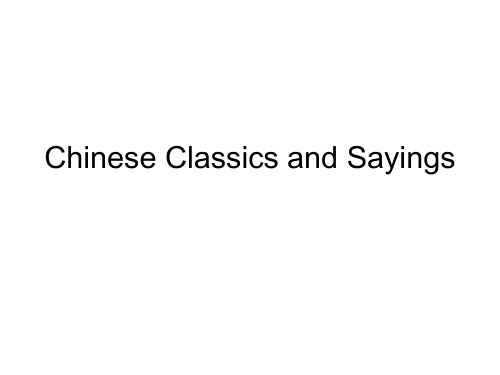
• 学而不思则罔,思而不学则殆。
• Learning without thinking leads to confusion; thinking without learning ends in danger. 学而不厌,诲人不倦。 • Never be contented with your study; never be impatient with your teaching. •
五经 Five Classics
• • • • • 《春秋》 《论语》 《孟子》 《大学》 《中庸》 • • • • • The Spring and Autumn Annals The Analects of Confucius The Words of Mencius The Great Learning The Doctrine of Mean
Chinese Classics and Sayings
四书Four Books
• • • • 《诗经》 《礼记》 《书经》《尚书》 《易经》
• • • •
The Book of Odes The Book of Rites The Book of History The Book of Changes
• 三人行,必有我师焉。择其善者而从之,其不善者而改之。 • Among any three people walking, I will find something to learn for sure. Their good qualities are to be followed, and their shortcomings are to be avoided. 学不可以已。青取之于蓝,而青于蓝;冰,水为之,而寒 于冰。君子博学而日参省乎己,则知明而行无过矣。 There is never an end to learning. The dye extracted from the indigo is bluer than the plant; so is the ice colder than the water. By broadly learning and constantly examining himself every day, the gentleman sharpens his awareness and makes fewer mistakes.
最值得收藏的中国古典名著英译精华
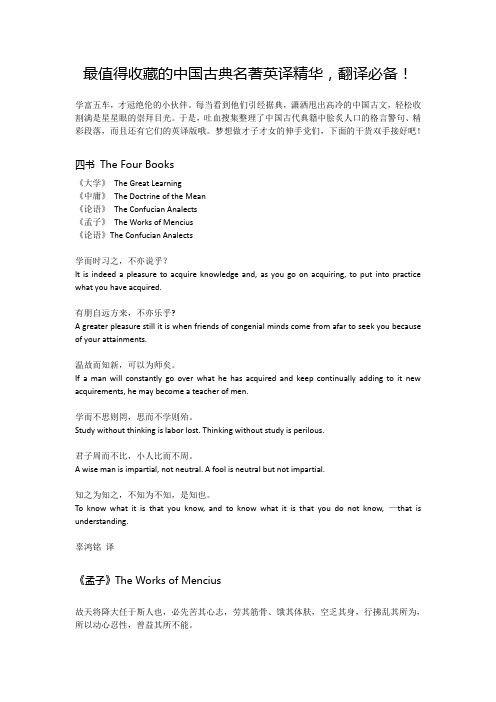
最值得收藏的中国古典名著英译精华,翻译必备!学富五车,才冠绝伦的小伙伴。
每当看到他们引经据典,潇洒甩出高冷的中国古文,轻松收割满是星星眼的崇拜目光。
于是,吐血搜集整理了中国古代典籍中脍炙人口的格言警句、精彩段落,而且还有它们的英译版哦。
梦想做才子才女的伸手党们,下面的干货双手接好吧!四书The Four Books《大学》The Great Learning《中庸》The Doctrine of the Mean《论语》The Confucian Analects《孟子》The Works of Mencius《论语》The Confucian Analects学而时习之,不亦说乎?It is indeed a pleasure to acquire knowledge and, as you go on acquiring, to put into practice what you have acquired.有朋自远方来,不亦乐乎?A greater pleasure still it is when friends of congenial minds come from afar to seek you because of your attainments.温故而知新,可以为师矣。
If a man will constantly go over what he has acquired and keep continually adding to it new acquirements, he may become a teacher of men.学而不思则罔,思而不学则殆。
Study without thinking is labor lost. Thinking without study is perilous.君子周而不比,小人比而不周。
A wise man is impartial, not neutral. A fool is neutral but not impartial.知之为知之,不知为不知,是知也。
24部中国名著的英文翻译
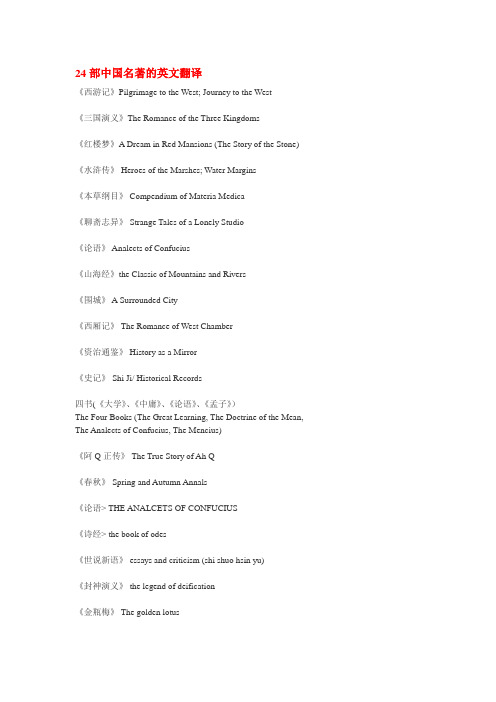
24部中国名著的英文翻译《西游记》Pilgrimage to the West; Journey to the West《三国演义》The Romance of the Three Kingdoms《红楼梦》A Dream in Red Mansions (The Story of the Stone)《水浒传》 Heroes of the Marshes; Water Margins《本草纲目》 Compendium of Materia Medica《聊斋志异》 Strange Tales of a Lonely Studio《论语》 Analects of Confucius《山海经》the Classic of Mountains and Rivers《围城》 A Surrounded City《西厢记》 The Romance of West Chamber《资治通鉴》 History as a Mirror《史记》 Shi Ji/ Historical Records四书(《大学》、《中庸》、《论语》、《孟子》)The Four Books (The Great Learning, The Doctrine of the Mean, The Analects of Confucius, The Mencius)《阿Q正传》 The True Story of Ah Q《春秋》 Spring and Autumn Annals《论语> THE ANALCETS OF CONFUCIUS《诗经> the book of odes《世说新语》 essays and criticism (shi shuo hsin yu)《封神演义》 the legend of deification《金瓶梅》 The golden lotus《西厢记》 The west chamber。
中国文化大集合--—你不可不知道的英文翻译

四大名著:三国演义Three Kingdms西游记Journey to the west红楼梦Dream of Red Mansions水浒传Heroes of the Marshes中国其他名作:大学The great leaning中庸The Doctrine of the Mean论语The Analects of Confucius孟子The Mencius孙子兵法The Art of War山海经The Classic of Mountains and Rivers 资治通鉴History as a Mirror春秋The Spring and Autumn Annals史记Historical Records诗经The Book of Songs易经The I Ching ;The book of changes礼记The Book of Rites三字经Three-character Scriptures八股文Eight-part essay中国诗:五言绝句Five-character quatrain七言律诗Seven-character octave中国装:旗袍Cheongsam中山装Chinese tunic suit唐装Tang suit节日与其他:阳历Solar calendar阴历Lunar calendar闰年Leap year春节The spring festival元宵节The lantem festival清明节The tomb-sweeping day端午节The dragon-boat festival中秋节The mid-autumn day重阳节The double-ninth day七夕节The double-seventh day春联Spring couplets中国四大发明:火药gunpowder印刷术printing造纸术paper-making指南针the compass中国教:道教Taoism墨家Mohism法家Legalism佛教Buddhism中国各教始祖:孔子Confucius孟子Mencius老子Lao Tzu庄子Chuang Tzu墨子Mo tzu孙子Sun Tzu文房四宝:笔墨纸砚The four treasures of the study : brush , ink stick , paper , ink stone 中国戏剧文化:五大剧1.京剧Peking opera2.豫剧Henan Opera3.越剧Yue Opera4.评剧Ping Opera5.黄梅戏Huangmei opera秦腔Qin opera昆曲Kunqu Opera粤剧Cantonese Opera淮剧Huai Opera河南坠子Henan zhuizi湖南花鼓戏Hunan Flower Drum Opera口技ventriloquism木偶戏puppet show皮影戏shadow play折子戏opera higlights杂技acrobatics相声witty dialogue comedy其它:功夫kungfu太极Tai chi刺绣embroidery苏绣Suzhou embroidery泥人clay figure书法calligraphy中国画traditiional Chinese painting 水墨画Chinese brush painting中国结Chinese knot风水Fengshui ;geomantic omen 十二生肖Zodiac。
中国古典文化佳作英译50首
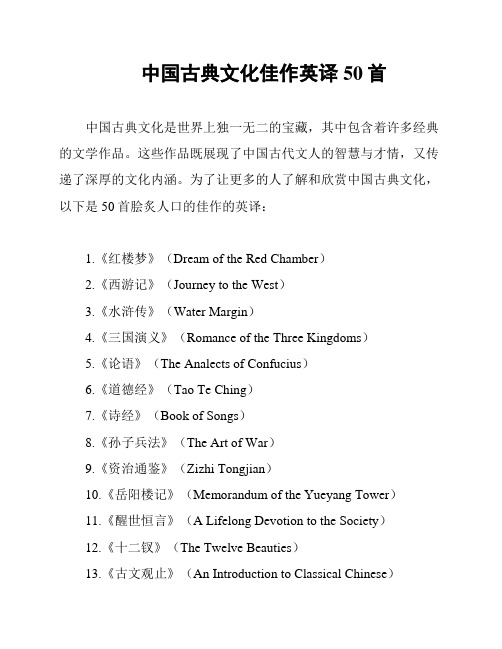
中国古典文化佳作英译50首中国古典文化是世界上独一无二的宝藏,其中包含着许多经典的文学作品。
这些作品既展现了中国古代文人的智慧与才情,又传递了深厚的文化内涵。
为了让更多的人了解和欣赏中国古典文化,以下是50首脍炙人口的佳作的英译:1.《红楼梦》(Dream of the Red Chamber)2.《西游记》(Journey to the West)3.《水浒传》(Water Margin)4.《三国演义》(Romance of the Three Kingdoms)5.《论语》(The Analects of Confucius)6.《道德经》(Tao Te Ching)7.《诗经》(Book of Songs)8.《孙子兵法》(The Art of War)9.《资治通鉴》(Zizhi Tongjian)10.《岳阳楼记》(Memorandum of the Yueyang Tower)11.《醒世恒言》(A Lifelong Devotion to the Society)12.《十二钗》(The Twelve Beauties)13.《古文观止》(An Introduction to Classical Chinese)14.《孔子家语》(The Family Sayings of Confucius)15.《庄子》(Zhuangzi)17.《新唐书》(New Book of Tang)18.《老子》(Laozi)19.《文心雕龙》(Literary Mind and the Carving of Dragons)20.《史记》(Records of the Grand Historian)21.《道藏》(Taoist Canon)23.《尚书》(Book of Documents)24.《浮生六记》(Six Records of a Floating Life)25.《唐诗三百首》(Three Hundred Tang Poems)27.《明史》(History of Ming)28.《天演论》(Natural Law in the Spiritual World)29.《荣宗正谱》(Genealogy of the Worthy Linage)30.《镜花缘》(The Romance of the Rose)31.《弟子规》(Standards for Being a Good Student and Child)32.《神雕侠侣》(The Return of the Condor Heroes)33.《富春山居图》(Dwelling in the Fuchun Mountains)35.《幼学琼林》(Young Learning in the Jade Forest)36.《山海经》(Classic of Mountains and Seas)37.《齐民要术》(Important Techniques for the Welfare of the People)39.《太乙金华宗旨》(The Secret of the Golden Flower)40.《七祖文集》(The Platform Sutra of the Sixth Patriarch)41.《楚辞》(Chu Ci)42.《农桑辑要》(Essentials for Peasants and Mulberry Planters)43.《论衡》(Discourses Weighed in the Balance)45.《龙图腾》(Dragon Totem)46.《儿女英雄传》(The Heroes and Heroines)47.《神仙传》(Biographies of Divine Immortals)48.《净世瑜伽论》(Yoga of Purification and Enlightenment)49.《高阳台忆峡山》(Memories of Xia Mountain from the High Sun Terrace)50.《统一魏武昭王伐蜀记》(Account of King Wei Wu's Conquest of Shu)这些作品涵盖了中国古代文化的方方面面,无论是小说、诗歌、历史还是哲学,都有着卓越的贡献。
中国文化词汇:古代典籍(英汉对照)

中国文化词汇:古代典籍(英汉对照)说到中国古代文化,四书五经和四大名著肯定是少不了的。
近几年,不少外国友人都对中国文化产生了浓厚的兴趣,要向他们介绍咱们的古代文学典籍,先把下面这些说法记下来吧!中国文化词汇:古代典籍四书The Four Books《大学》The Great Learning《中庸》The Doctrine of the Mean《论语》The Analects of Confucius《孟子》The Mencius中国文化词汇:古代典籍五经The Five Classics《诗经》The Book of Songs《书经》The Book of History《易经》The Book of Changes《礼记》The Book of Rites《春秋》The Spring and Autumn Annals中国文化词汇:古代典籍古代典籍Famous Ancient Books《史记》Historical Records《山海经》The Classic of Mountains and Rivers 《本草纲目》Compendium of Materia Medica《资治通鉴》History Retold as a Mirror for Rulers《西厢记》The Romance of West Chamber《三国演义》The Romance of the Three Kingdoms《水浒传》Heroes of the Marshes ; Water Margins《西游记》Pilgrimage to the West《红楼梦》Dream of the Red Mansions ; The story of the Stone 《聊斋志异》Strange Tales of a Lonely Studio中国文化词汇:古代典籍六艺Six classical arts礼rites乐music射archery御riding书writing数arithmetic古代文学常见体裁Genres of the ancient literature朦胧诗misty poetry三字经three-character scripture武侠小说tales of roving knights; martial arts novel; a kung fu novel言情小说romantic fiction; sentimental novel 八股文eight-part essay; stereotyped writing 五言绝句five-character quatrain七言律诗seven-character octave。
24部中国名著的英文翻译
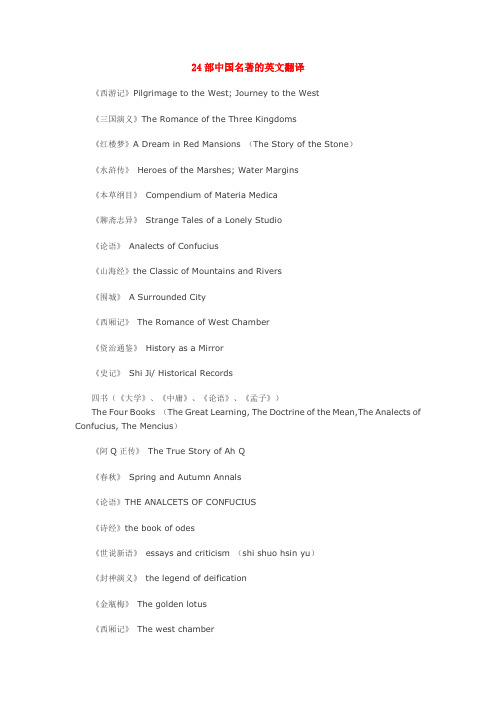
24部中国名著的英文翻译《西游记》Pilgrimage to the West; Journey to the West《三国演义》The Romance of the Three Kingdoms《红楼梦》A Dream in Red Mansions (The Story of the Stone)《水浒传》Heroes of the Marshes; Water Margins《本草纲目》Compendium of Materia Medica《聊斋志异》Strange Tales of a Lonely Studio《论语》Analects of Confucius《山海经》the Classic of Mountains and Rivers《围城》 A Surrounded City《西厢记》The Romance of West Chamber《资治通鉴》History as a Mirror《史记》Shi Ji/ Historical Records四书(《大学》、《中庸》、《论语》、《孟子》)The Four Books (The Great Learning, The Doctrine of the Mean,The Analects of Confucius, The Mencius)《阿Q正传》The True Story of Ah Q《春秋》Spring and Autumn Annals《论语》THE ANALCETS OF CONFUCIUS《诗经》the book of odes《世说新语》essays and criticism (shi shuo hsin yu)《封神演义》the legend of deification《金瓶梅》The golden lotus《西厢记》The west chamber。
24部中国名著英语翻译大全

24部中国名著英语翻译大全《西游记》Pilgrimage to the West; Journey to the West《三国演义》The Romance of the Three Kingdoms《红楼梦》A Dream in Red Mansions (The Story of the Stone)《水浒传》 Heroes of the Marshes; Water Margins《本草纲目》 Compendium of Materia Medica《聊斋志异》 Strange Tales of a Lonely Studio《论语》 Analects of Confucius《山海经》the Classic of Mountains and Rivers《围城》 A Surrounded City《西厢记》 The Romance of West Chamber《资治通鉴》 History as a Mirror《史记》 Shi Ji/ Historical Records四书(《大学》、《中庸》、《论语》、《孟子》)The Four Books (The Great Learning, The Doctrine of the Mean,The Analects of Confucius, The Mencius)《阿Q正传》 The True Story of Ah Q《春秋》 Spring and Autumn Annals《论语> THE ANALCETS OF CONFUCIUS《诗经> the book of odes《世说新语》 essays and criticism (shi shuo hsin yu)《封神演义》 the legend of deification《金瓶梅》 The golden lotus《西厢记》 The west chamber。
- 1、下载文档前请自行甄别文档内容的完整性,平台不提供额外的编辑、内容补充、找答案等附加服务。
- 2、"仅部分预览"的文档,不可在线预览部分如存在完整性等问题,可反馈申请退款(可完整预览的文档不适用该条件!)。
- 3、如文档侵犯您的权益,请联系客服反馈,我们会尽快为您处理(人工客服工作时间:9:00-18:30)。
中国文化典籍英译Introduction:Chinese culture is rich and diverse, with a long history that dates back thousands of years. One of the most important aspects of Chinese culture is its literature, which includes a vast collection of classical texts known as "典籍" (diǎnjí). These texts cover a wide range of topics, including philosophy, history, poetry, and more. Translating these cultural treasures into English is crucial for promoting cross-cultural understanding and sharing Chinese wisdom with the world. In this text, we will explore the standard format and guidelines for translating Chinese cultural classics into English.1. Understanding the Cultural Context:Before starting the translation process, it is essential to have a deep understanding of the cultural context surrounding the text. This includes knowledge of Chinese history, philosophy, and literary traditions. Familiarize yourself with the time period in which the text was written, the author's background, and the societal influences that shaped the work. This understanding will help you accurately convey the intended meaning and nuances of the original text in English.2. Accuracy and Faithfulness to the Original:When translating Chinese cultural classics, it is crucial to prioritize accuracy and faithfulness to the original text. Pay close attention to the author's style, syntax, and word choices. Strive to retain the original meaning while adapting it to the target language. Avoid adding personal interpretations or biases that may distort the author's intentions. A faithful translation will preserve the essence of the original work and allow readers to experience the beauty and depth of Chinese culture.3. Language and Style:Translating Chinese cultural classics into English requires a mastery of both languages. The translator should possess a strong command of Chinese and Englishgrammar, vocabulary, and syntax. It is important to choose appropriate English equivalents for Chinese idioms, metaphors, and cultural references. Consider the target audience and aim for a style that is accessible and engaging. Maintain a balance between preserving the original text's literary qualities and ensuring readability for English-speaking readers.4. Footnotes and Annotations:Chinese cultural classics often contain references to historical events, figures, and cultural practices that may be unfamiliar to non-Chinese readers. To provide necessary context and enhance understanding, footnotes and annotations can be added to the translated text. Footnotes should be concise and provide explanations or additional information without interrupting the flow of the main text. Annotations can be used for more extensive explanations or discussions of specific cultural elements.5. Consistency and Coherence:Maintaining consistency and coherence throughout the translation is essential. Use consistent terminology for recurring concepts, names, and phrases. Pay attention to the logical flow of ideas and ensure that the translated text reads smoothly and coherently. Consider the overall structure of the text and how individual sections relate to each other.A well-structured translation will help readers navigate the complexities of the original work and fully appreciate its cultural significance.6. Editing and Proofreading:Once the translation is complete, thorough editing and proofreading are necessary to ensure accuracy and quality. Review the translated text for any grammatical errors, typos, or inconsistencies. Verify that the translation accurately reflects the original text's meaning and intent. Consider seeking feedback from native speakers or experts in the field to further refine the translation. A well-edited and polished translation will enhance its credibility and readability.Conclusion:Translating Chinese cultural classics into English is a challenging yet rewarding endeavor. It requires a deep understanding of both Chinese and English languages, as well as a profound knowledge of Chinese history and culture. By following the standard format and guidelines outlined above, translators can accurately convey the beauty and wisdom of Chinese literature to a global audience. Through these translations, we can bridge cultural gaps and foster a greater appreciation for the richness of Chinese culture.。
